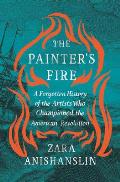While
Henry Pelham’s picture of the
Boston Massacre is often analyzed as a political cartoon, I suspect he was aiming for something more akin to a history painting.
British
artists considered history painting—portraying a dramatic moment from history, myth, religious scripture, or even a theatrical play—as one of the highest forms of visual art at this time. In 1760 the Society of Artists of Great Britain started to award annual “premiums,” or large prizes, for paintings of subjects from British history.
At first those British history paintings were from the distant past.
Robert Edge Pine won a premium in 1763 for a picture of King Canute and his mother, for instance. But there was interest in showing show more recent history, too.
Benjamin West’s first history paintings showed scenes from classical times, but in 1768 he painted a British general magnanimously saving a
French prisoner, and in 1770, the same year as the Massacre, he went all out with a large canvas of the death of Gen.
James Wolfe, shown in modern
dress with recognizable living men around him.
In West’s first letter to
John Singleton Copley in June 1767, he explained that he had been too busy to write before because “history Painting…demands the greates Cear and intelehance in History amaginable.” In that letter West offered advice about manipulating color and light to draw viewers’ eyes to the most important figures in a picture:
Thare is in Historical Painting this Same attention to be Paid. For if the Principl Carrictors are Suffred to Stand in the Croud, and not distinguished by light and shadow, or made Conspicuous by some Pece of art, So that the Eye is first Caut by the Head Carrictor of the History, and So on to the next as he bears Proportion to the Head Carrictor, if this is not observed the whole is Confusion and looses that dignity we So much admier in Great works.
Copley was Henry Pelham’s older half-brother and mentor as an artist. Compare the advice he received from West with how Pelham kept Capt.
Thomas Preston’s head on the right of his image in the foreground against white space while the soldiers recede into smoke. Likewise on the left, victims’ faces stand out while much of the crowd is in shadow. Pelham used hatching to darken the background figures.
We don’t know if Copley shared West’s advice with Pelham, but we do know the half-brothers discussed history painting when Copley was first viewing art in Europe and Pelham was trying to emulate his career in Boston. “My Dear Harry,” Copley wrote to from Paris in September 1774, “as you proceed invent Historical Subjects. possess Sr.
Josa. Renolds lectures as soon as you can,—some of the Book Dealers will send for them for you—and they will tell you how to proceed in the management of those great Subjects.”
In the spring of 1775 Copley wrote, “You will be glad to know in what manner a Historical composition is made, so I will give it to you, in that way I have found best myself to proceed.” He then went on
for several pages.
Reaching Italy in June 1775, Copley wrote, “you should than (as I would have you) sketch any Historical Subject. . . . I don’t think a Man a perfect Artist who on occation cannot Paint History, and who knows but you have a talent in history like Raphael till you try; and if you have, your fortune is secure in this Life.”
Of course, being a history painter was Copley’s own ambition. He felt frustrated at how his American customers wanted portraits only. After settling in Britain, Copley put a lot of time and energy into creating magnificent scenes of the
British army winning parts of the American War far from America.
Now I’m not saying that Henry Pelham’s 1770 Boston Massacre image
was a history painting. It’s not a painting at all, of course. In Britain, West still had to argue the case that it was valid to treat a recent event in that high-brow fashion. But Pelham’s picture has more in common with that artistic genre than with contemporaneous political prints, which usually take place on a generic and often blank landscape, feature allegorical figures, and sometimes use unrealistic techniques like word balloons.
With the exception of the dog in the center foreground, no elements in Pelham’s painting are wholly symbolic or unreal. And even the dog isn’t vomiting, urinating, or doing the other distasteful things that dogs often did in political cartoons. Pelham reserved his symbolic imagery for the bottom margin, where he etched a skull and crossbones and lightning shattering a sword.
Analyzing Pelham’s print as akin to a history painting doesn’t mean treating it as an attempt to depict the shooting on King Street exactly as it happened. Artists composed their history paintings for emotional and polemical effect, as West’s advice reveals. But they did so less obviously than when they drew cartoons.
As
Paul Revere copied Pelham’s image, he
added the label “Butcher’s Hall” to the
Customs House, thus inserting a fictional label into the scene to hammer home its political message. That moved the picture closer to cartoon form. Even then, the result was a long way from Revere’s
“View of the Year 1765,” “A Warm Place—Hell,” and other political art. And Revere didn’t bother with most of the hatching.







